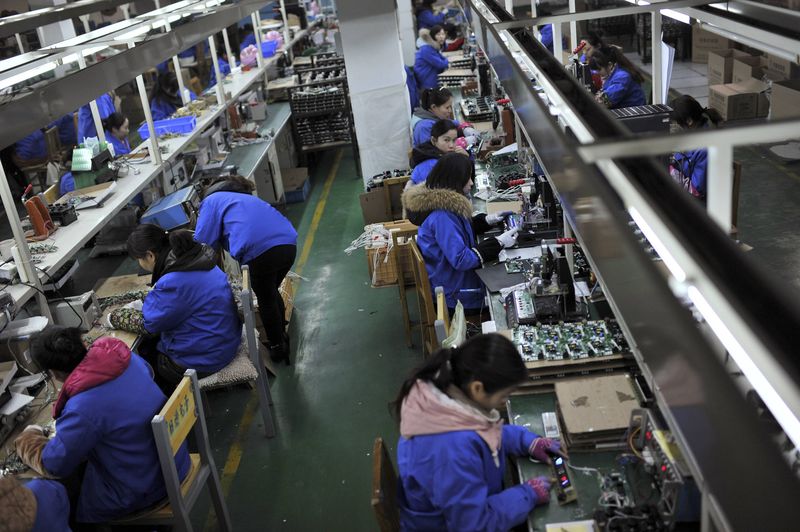SHANGHAI (Reuters) - Activity in China's factory sector shrank for the second straight month in January, a private business survey showed on Monday, as the new year got off to a rocky start for the world's second-largest economy.
The slack performance, including a 15th month of shrinking factory employment, will add to the debate over how and whether Beijing will accelerate policy easing, with most bank economists calling for a combination of rate cuts and increased liquidity to spur productive investment.
The final HSBC/Markit Purchasing Managers' Index (PMI) for January came in at 49.7 on a seasonally adjusted basis, just below the 50.0 level that separates growth from contraction. The number was slightly lower than a preliminary "flash" reading of 49.8 but higher than the final 49.6 in December.
"Demand in the manufacturing sector remains weak and more aggressive monetary and fiscal easing measures will be needed to prevent another sharp slowdown in growth," said Hongbin Qu, China chief economist at HSBC.
The dour data mirrored two official reports released by the government on Sunday which showed weakness in China's manufacturing and services sectors last month.
The official PMI - which is biased towards large Chinese factories - unexpectedly showed manufacturing activity shrank for the first time in nearly 2-1/2 years and firms saw more gloom ahead.
"We think targeted measures remain the first policy option," said Tim Condon at ING.
"The November policy rate cut was preceded by complaints by Premier Li about the lack of credit flow to businesses and we will be looking for similar hints to gauge the likelihood of a bazooka stimulus," he said, adding that he didn't consider the sub-50 official reading particularly surprising given seasonal factors and wider economic trends.
In the private survey, there was marginal expansion in new orders and new export orders, though both were revised downward from the earlier "flash" estimates.
Jobs shrank for the 15th consecutive month, but the rate slowed, with the subindex reading at 49.5 in January compared to 49.3 in December.
The slide is keeping pressure on Beijing to increase the pace at which workers migrate into services from once high-paying factory jobs, a challenging proposition given weak investment in retraining.
More worrisome was the sharp slide in input costs, which fell at their steepest rate since March 2009, with lower prices for oil and steel playing major roles in the decline.
Ordinarily, cheaper energy prices would be good for China, one of the world's most intensive energy consumers, but most economists believe the phenomenon is a net negative for Chinese firms because of its impact on ultimate demand.
"Lower commodity prices mean that China's own energy, mining and metals-processing firms are suffering. And when this big group of firms cuts back on capital spending, demand for machinery and industrial products weakens," wrote Thomas Gatley of Gavekal Dragonomics in a recent research note.
"Add in the ongoing slump in construction activity, and the commodity correction means 2015 is shaping up to be the worst year for Chinese industry since the global financial crisis."
Not all of Monday's PMI report was bad. Output recovered for the first time since October, although only marginally, with muted demand keeping a lid on it.

Hurt by a sagging property market, unsteady exports and cooling domestic demand and investment, China's economic growth is expected to slow to 7 percent this year even with further stimulus measures.